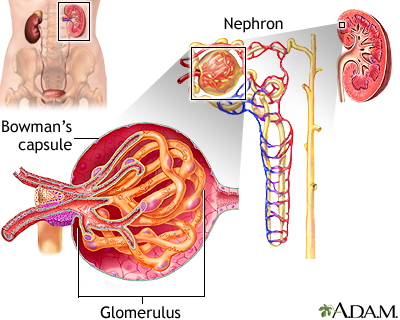Minimal change disease
Minimal change nephrotic syndrome; Nil disease; Lipoid nephrosis; Idiopathic nephrotic syndrome of childhood
Minimal change disease is a kidney disorder that can lead to nephrotic syndrome. Nephrotic syndrome is a group of symptoms that include protein in the urine, low blood protein levels in the blood, high cholesterol levels, high triglyceride levels, and swelling.
Images

I Would Like to Learn About:
Causes
Each kidney is made of more than a million units called nephrons, which filter blood and produce urine.
In minimal change disease, there is damage to the glomeruli. These are the tiny blood vessels inside the nephron where blood is filtered to make urine and waste is removed. The disease gets its name because this damage is not visible under a regular microscope. It can only be seen under a very powerful microscope called an electron microscope.
Minimal change disease is the most common cause of nephrotic syndrome in children. It is also seen in adults with nephrotic syndrome, but is less common.
The cause is unknown, but the disease may occur after or be related to:
- Allergic reactions
- Use of non-steroidal anti-inflammatory drugs (NSAIDs)
- Tumors
- Vaccinations (flu and pneumococcal, though rare)
- Viral infections
Symptoms
There may be symptoms of nephrotic syndrome, including:
- Foamy appearance of the urine
- Poor appetite
- Swelling (especially around the eyes, feet and ankles, and in the abdomen)
- Weight gain (from fluid retention)
Minimal change disease does not reduce the amount of urine produced. It rarely progresses to kidney failure.
Exams and Tests
The health care provider may not be able to see any signs of the disease, other than swelling. Blood and urine tests reveal signs of nephrotic syndrome, including:
- High level of cholesterol in the blood
- High levels of protein in the urine
- Low levels of albumin in the blood
A kidney biopsy and examination of the tissue with an electron microscope can show signs of minimal change disease.
Treatment
Medicines called corticosteroids (or steroids) can cure minimal change disease in most children. Some children may need to stay on steroids to keep the disease from returning.
Steroids are effective in adults, but less so in children. Adults may have more frequent relapses and become dependent on steroids.
If steroids are not effective, the provider will likely suggest other medicines.
Swelling may be treated with:
- ACE inhibitor medicines
- Blood pressure control
- Diuretics (water pills)
You may also be told to reduce the amount of salt in your diet.
Outlook (Prognosis)
Children usually respond better to corticosteroids than adults. Children often respond within the first month of treatment.
A relapse can occur. The condition may improve after long-term treatment with corticosteroids and medicines that suppress the immune system (immunosuppressants).
When to Contact a Medical Professional
Contact your provider if:
- You develop symptoms of minimal change disease
- You have this disorder and your symptoms get worse
- You develop new symptoms, including side effects from the medicines used to treat the disorder
Related Information
Nephrotic syndromeAcute kidney failure
References
Erkan E. Nephrotic syndrome. In: Kliegman RM, St. Geme JW, Blum NJ, et al, eds. Nelson Textbook of Pediatrics. 22nd ed. Philadelphia, PA: Elsevier; 2025:chap 567.
Radhakrishnan J, Appel GB, D'Agati VD. Secondary glomerular disease. In: Yu ASL, Chertow GM, Luyckx VA, Marsden PA, Skorecki K, Taal MW, eds. Brenner and Rector's The Kidney. 11th ed. Philadelphia, PA: Elsevier; 2020:chap 32.
BACK TO TOPReview Date: 12/31/2023
Reviewed By: Walead Latif, MD, Nephrologist and Clinical Associate Professor, Rutgers Medical School, Newark, NJ. Review provided by VeriMed Healthcare Network. Also reviewed by David C. Dugdale, MD, Medical Director, Brenda Conaway, Editorial Director, and the A.D.A.M. Editorial team.

Health Content Provider
06/01/2025
|
A.D.A.M., Inc. is accredited by URAC, for Health Content Provider (www.urac.org). URAC's accreditation program is an independent audit to verify that A.D.A.M. follows rigorous standards of quality and accountability. A.D.A.M. is among the first to achieve this important distinction for online health information and services. Learn more about A.D.A.M.'s editorial policy, editorial process and privacy policy. A.D.A.M. is also a founding member of Hi-Ethics. This site complied with the HONcode standard for trustworthy health information from 1995 to 2022, after which HON (Health On the Net, a not-for-profit organization that promoted transparent and reliable health information online) was discontinued. |
The information provided herein should not be used during any medical emergency or for the diagnosis or treatment of any medical condition. A licensed medical professional should be consulted for diagnosis and treatment of any and all medical conditions. Links to other sites are provided for information only -- they do not constitute endorsements of those other sites. © 1997- 2025 A.D.A.M., a business unit of Ebix, Inc. Any duplication or distribution of the information contained herein is strictly prohibited.
